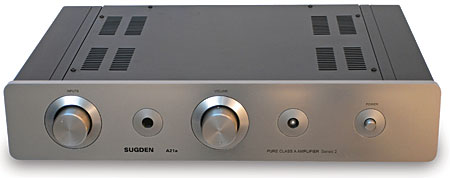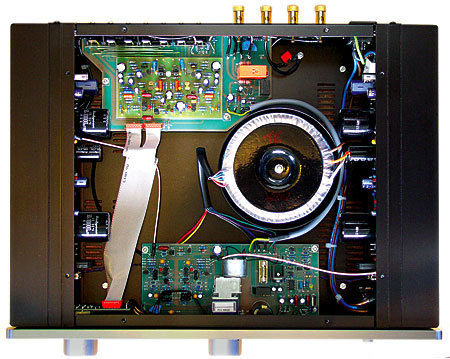| Columns Retired Columns & Blogs |
Sugden A21ai Series 2 integrated amplifier
Winter has returned to Cherry Valley, New York, and I'm reminded of a bad habit that I used to conceal: On cold mornings I started my car well before driving off, then actually weighted down the accelerator pedal—with the heavy socket tray from my toolbox—in an effort to keep the idle high, and thus more quickly warm the windshield and the interior. Whether my lazy trick had the desired effect is a matter of some debate, but I wish now that I hadn't been so wasteful and so casually fouled the air.

Now I'm happy just to stay at home, listening to music through my favorite class-A amplifiers: just as wasteful, I suppose, but on a small enough scale that I can squint and pretend I don't see it. In a pure class-A amplifier, output devices are biased at a high enough negative voltage that current never ceases to flow across them, even when one device in a complementary pair hands off the signal to the other. This preserves the integrity of the waveform continuum and banishes so-called switching distortion. The amps stay nice and warm, too.
So it goes with the audio amplifiers designed and manufactured by J.E. Sugden & Co., Ltd., the English firm named for a founder who has long since retired. "Sugden's," in fact, suggests that they were the first company to produce a solid-state class-A amplifier for domestic use their original A21 model, introduced in the 1960s. Today, alongside various preamplifiers and CD players, J.E. Sugden & Co. offers a number of basic and integrated amplifiers, all solid-state, and all with output stages said to operate in class-A. Nice.
Description
The A21ai Series 2 ($2995), which has both line-level and phono inputs, was introduced at the same time as its stablemate, the A21al Series 2 ($2795), a line-only product upgradeable to line-plus-phono status whenever its owner pleases. Because in many fonts the numeral 1 and the lowercase l appear identical, and because poor eyesight makes the lowercase i look very much the same as the other two, I'll spell it out: The one with the built-in phono preamp is the "ay twenty-one ay eye," and the line-only version is the "ay twenty-one ay ell." Owing to the mildly confusing nomenclature, and because I have difficulty pronouncing Sugden, my wife and daughter are under the impression that the product I'm reviewing this month is simply called the warm, silver amp.
The warm, silver amp is directly descended from the Sugden A21a integrated amplifier, which Sam Tellig reviewed in Stereophile in February 2005, and which also impressed John Marks and other reviewers. The new model has virtually the same output section as the old, using only NPN output transistors in what is said to be a single-ended topography, yielding about 25Wpc into an 8-ohm load. A key difference is that the Sugden A21ai Series 2 has a much sturdier power supply, with about 50% more current available to the output section. The result is that full or nearly full power is available under a greater range of operating conditions. Flat power response and low distortion are maintained through the use of current (not voltage) feedback, at about 50% of gain.
The active preamplifier section of the A21a has also been changed for the new model: In order to achieve a purer and, I dare say, straighter signal path, both the Balance knob and Mono switch of the older model have been eliminated. (You can guess how I feel about that.) Consequently, the front panel is more austere than it used to be, and arguably a good deal more attractive: thicker, heavier, and available in a choice of titanium (silver) or graphite (dark gray) finishes. From left to right are an unlabeled Inputs selector switch (you might have to count the number of clicks to know which source you're hearing), a lens for the remote-control IR receiver, a Volume knob, a blue pilot light, and a Power switch.
The rear panel is busier, with phono jacks for the inputs and the outputs—the latter including buffered tape-out and preamplifier-out jacks—and decent-looking gold-plated terminals for the speaker outputs. The AC cord is detachable, in case you want to use a fancier one. The Sugden A21ai Series 2 also betters its predecessor by including a remote handset, with which the user can adjust the amplifier's motorized volume control—but nothing else.

The construction quality is superb—and here I must pause and tell you a bit more about Sugden & Co. itself. They've been in the same West Yorkshire building for a long time, and their operation is reportedly so self-sufficient that they still manufacture their own casework and stuff and solder their own circuit boards. Sugden employees are more valued craftsmen than assembly-line slaves; for that reason, and because the company's product line has for so long remained so stable and so united in meeting a common design goal—as opposed to zigging and zagging from this idea to that and dropping products within one or two years of their introduction—I can't help thinking of J.E. Sugden & Co. as the Morgan Motorcars of British audio. And that's a compliment.
Installation and setup
My first observation on having set up the A21ai Series 2 is probably the most important: Since its output section is biased to run well into, if not all the way into, class-A, this amp runs hotter than hell's kitchenette. I was never troubled by that, and had no reliability problems whatsoever with the Sugden, but the prospective owner absolutely must put it on a shelf where nothing will prevent its casework from shrugging off heat. Ignore that advice at the peril of your output devices.
Apart from that, the A21ai had nothing up its sleeve. It seemed more or less indifferent to choice of speaker cable—in whatever system the amp was used at a given time, cable changes made little audible difference—and while substituting a very expensive AC cord for the stock item made a subtle improvement, I don't see much point in pairing an integrated amplifier with any accessory that costs more than half its own price. Placing three Ayre Myrtle Block isolation spacers between amp and shelf actually made the A21ai sound noticeably worse: It took on a hollow, ringy timbre that didn't appeal to me at all. I assume that the Sugden's chassis was tuned long ago to function quite well as is.
I took advantage of the Sugden's preamp-out jacks, using them to drive my refurbished Quad II monoblocks. This worked well enough, although I observed that most of the Sugden's very generous gain is apparently provided by its power-amp stage.
With its own output section back in play, the Sugden A21ai Series 2 did a fine job of driving my pair of refurbished Quad ESL loudspeakers in the larger (21' by 27') of my two listening rooms. With an impedance range that is, literally, exponentially wide, the ESL is a difficult load to manage, yet the Sugden pulled it off nicely. (Only after my time with the amplifier was up did I learn that the original Quad ESL is one of the references used by Sugden themselves. And Sugden importer George Stanwick, of Stanalog, Inc., is himself an ESL enthusiast.) In my smaller (12' by 19') room, the Sugden drove a much kinder load: a pair of Audio Note AN-e SPe HE speakers.
The gain of the phono section of the A21ai Series 2 can be set for either moving-magnet or low-output moving-coil cartridges simply by repositioning four tiny jumper blocks on the phono-preamp board. The former setting gives you a resistive load of 47k ohms, the latter a load of 100 ohms—sensible choices both.
Though the otherwise fine owner's manual doesn't mention it, it seemed to me that the A21ai inverted the absolute phase of input signals. Music seemed minutely louder and more present when both speaker leads were reversed, hot for ground. But I might've imagined it.
Listening
Because stories about setting up hi-fi equipment have little appeal for people who aren't themselves merchants of tedium, I'll cut to the chase: To sound its best, the Sugden A21ai Series 2 needed lots of run-in and warmup. Because my review sample had spent some time at the 2008 Rocky Mountain Audio Fest before arriving here in upstate New York, I assumed that it was ready to rock; nevertheless, I had to play several albums' worth of music through it before its sound opened up. Even the simple act of turning it off and moving it from one system to another caused the amp to lose a little ground: Each time/day I used it, the A21 needed at least a half-hour of playing time before reaching its full performance potential—prior to which it sounded dull and overly thick, yet lacking in bass and treble extension.
A few days into my critical listening, the Sugden's real strengths became apparent: It sounded consistently sweet and dependably comfortable, in the mold of the great class-A amps of the late 1970s and early 1980s—like an early Electrocompaniet Ampliwire, which was something I tended to admire.
- Log in or register to post comments




































